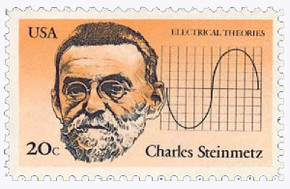
U.S. #2056
1983 20¢ Edwin Armstrong
American Inventors
- From a block of 4 stamps issued to honor some of America's top inventors
- Features a portrait and depiction of his invention
Stamp Category: Commemorative
Set: American Inventors
Value: 20¢, first-class rate
First Day of Issue: September 21, 1983
First Day City: Washington, DC
Quantity Issued: 48,263,750
Printed by: Bureau of Engraving and Printing
Printing Method: Lithographed and engraved
Format: Panes of 50 in sheets of 200
Perforations: 11
Why the stamp was issued: To honor one of America's top inventors.
About the stamp design: Designed by Dennis Lyall, the Edwin Armstrong stamp pictures the inventor alongside his frequency modulator.
First Day City: The designs for the block of four American Inventors stamps were unveiled three months earlier at a banquet marking the 10th anniversary of the Institute of Electrical and Electronic Engineers. Each of the four inventors had a connection to the institute or one of its two predecessors. The First Day ceremony for the stamps was held at the US Patent and Trademark Office in Arlington, Virginia.
Unusual fact about this stamp: Error stamps exist with the black intaglio missing or dramatically shifted.
About the American Inventors Set: Dennis Lyall designed the block of four American Inventors stamps. As each man had lived since the advent of the camera, he was able to create his stamp portraits from photographs. He also included text describing the invention or discovery they were best known for as well as a depiction of it.
Other stamps in the set picture:
Charles Steinmetz – Electrical Theories – This is the only stamp in the set that doesn’t picture a physical invention. Instead, it pictures a graph representing the square root of minus one.
Nikola Tesla beside his induction motor;
Philo T. Farnsworth with his first television camera.
History the stamp represents: Edwin Armstrong was an electrical engineer who developed the theory of frequency modulation (FM) for use in radio. FM broadcasts give superior sound quality to AM (amplitude modulation). Armstrong patented wideband FM in 1933, but it took years for the work to be fully developed. He received the “Legion of Honor” (the highest decoration) from the French government in 1919 for his wartime work with radio.










